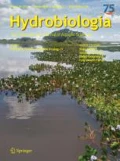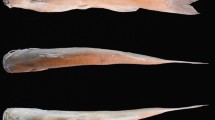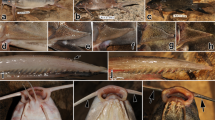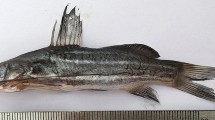Abstract
Integrative approaches are particularly useful to resolve taxonomic uncertainties in species-rich groups that have undergone explosive radiation, such as Hypostomini (suckermouth armored catfishes). This tribe encompasses the genera Hypostomus and Pterygoplichthys, but the actual number of species in each genus and the intergeneric interrelationships are confusing or unknown for some ecoregions in the Neotropics. Here, we analyzed three endemic species Hypostomus chrysostiktos, H. jaguar and H. unae from Northeastern Mata Atlântica in northeastern Brazil based on meristic characters, geometric morphometrics, chromosomal data, DNA barcode and species delimitation algorithms. The current taxonomic status of these catfishes is challenged. While H. unae and H. jaguar revealed a close evolutionary relationship similar to those observed within Hypostomus from other basins, H. chrysostiktos was herein more closely related to Pterygoplichthys, being invariably recovered as a highly distinctive taxonomic unit than to Hypostomus. Therefore, we recommend the reallocation of H. chrysostiktos as Pterygoplichthys chrysostiktos and a thorough systematic review of Pterygoplichthys, particularly focusing on putative convergence traits in relation to Hypostomus.





Similar content being viewed by others
References
Abell, R., M. L. Thieme, C. Revenga, M. Bryer, M. Kottelat, N. Bogutskaya, B. Coad, N. Mandrak, S. Contreras Balderas, W. Bussing, M. L. J. Stiassny, P. Skelton, G. R. Allen, P. Unmack, A. Naseka, R. Ng, N. Sindorf, J. Robertson, E. Armijo, J. V. Higgins, T. J. Heibel, E. Wikramanake, D. Olson, H. L. Lopez, R. E. Reis, J. G. Lundberg, M. H. Sabaj Perez & P. Petry, 2008. Freshwater ecoregions of the world: a new map of biogeographic units for freshwater biodiversity conservation. BioScience 58: 403–414.
Alves, A. L., C. Oliveira, M. Nirchio, A. Granado & F. Foresti, 2006. Karyotypic relationships among the tribes of Hypostominae (Siluriformes: Loricariidae) with description of XO sex chromosome system in a Neotropical fish species. Genetica 128: 1–9.
Armbruster, J. W., 1998a. Modifications of the digestive tract for holding air in loricariid and scoloplacid catfishes. Copeia 1998: 663–675.
Armbruster, J. W., 1998b. Modifications of the digestive tract for holding air in loricariid and scoloplacid catfishes. Copeia 3: 663–675.
Armbruster, J. W., 2004. Phylogenetic relationships of the suckermouth armored catfishes (Loricariidae) with emphasis on the Hypostominae and the Ancistrinae. Zoological Journal of the Linnean Society 141: 1–80.
Armbruster, J. W. & L. Page, 1996. Redescription of Aphanotorulus (Teleostei: Loricariidae) with description of one new species, A. ammophilus, from the Rio Orinoco Basin. Copeia 2: 379–389.
Armbruster, J. W. & L. M. Page, 2006. Redescription of Pterygoplichthys punctatus and description of a new species of Pterygoplichthys (Siluriformes: Loricariidae). Neotropical Ichthyology 4: 401–409.
Armbruster, J. W., D. C. Werneke & M. Tan, 2015. Three new species of saddled loricariid catfishes and a review of Hemiancistrus, Peckoltia and allied genera (Siluriformes). ZooKeys 480: 97–123.
Artoni, R. F. & L. A. C. Bertollo, 2001. Trends in the karyotype evolution of Loricariidae fish (Siluriformes). Hereditas 134: 201–210.
Birindelli, J. L. O., A. M. Zanata & F. C. T. Lima, 2007. Hypostomus chrysostiktos, a new species of armored catfish (Siluriformes: Loricariidae) from Rio Paraguaçu, Bahia State, Brazil. Neotropical Ichthyology 5: 271–278.
Bitencourt, J. A., P. R. A. M. Affonso, L. Giuliano-Caetano & A. L. Dias, 2011a. Identification of distinct evolutionary units in allopatric populations of Hypostomus cf. wuchereri Günther, 1864 (Siluriformes: Loricariidae): karyotypic evidence. Neotropical Ichthyology 9: 317–324.
Bitencourt, J. A., P. R. A. M. Affonso, L. Giuliano-Caetano & A. L. Dias, 2011b. Heterochromatin heterogeneity in Hypostomus prope unae (Steindachner, 1878) (Siluriformes, Loricariidae) from Northeastern Brazil. Comparative Cytogenetics 5: 329–344.
Bitencourt, J. A., P. R. A. M. Affonso, L. Giuliano-Caetano, P. L. S. Carneiro & A. L. Dias, 2012. Population divergence and peculiar karyoevolutionary trends in the loricariid fish Hypostomus aff. unae from northeastern Brazil. Genetics and Molecular Research 11: 933–943.
Bittner, L., S. Halary, C. Payri, C. Cruaud, B. Reviers, P. Lopez & E. Bapteste, 2010. Some considerations for analyzing biodiversity using integrative metagenomics and gene networks. Biology Direct 5: 47.
Bockmann, F. A. & A. C. Ribeiro, 2003. Description of a new suckermouth armored catfish of the genus Pareiorhina (Siluriformes: Loricariidae) from southeastern Brazil. Ichthyological Exploration of Freshwaters 3: 231–242.
Boeseman, M., 1968. The genus Hypostomus Lacépède, 1803, and its Surinam representatives (Siluriformes, Loricariidae). Zoologische Verhandelingen 99: 1–89.
Bookstein, F. L., 1991. Morphometric Tools for Landmark Data: Geometry and Biology. Cambridge University Press, Cambridge: 435p.
Brown, S. D. J., R. A. Collins, S. Boyer, C. Lefort, J. Malumbres-Olarte, C. J. Vink & R. H. Cruickshank, 2012. SPIDER: an R package for the analysis of species identity and evolution, with particular reference to DNA barcoding. Molecular Ecology Resources 12: 562–565.
Bueno, V. S., C. H. Zawadzki & V. P. Margarido, 2012. Trends in chromosome evolution in the genus Hypostomus Lacépède, 1803 (Osteichthyes, Loricariidae): a new perspective about the correlation between diploid number and chromosomes types. Reviews in Fish Biology and Fisheries 22: 241–250.
Bueno, V. S., J. T. Konerat, C. H. Zawadzki, P. C. Venere, D. R. Blanco & V. P. Margarido, 2018. Divergent chromosome evolution in Hypostominae tribes (Siluriformes: Loricariidae): correlation of chromosomal data with morphological and molecular phylogenies. Zebrafish 5: 492–503.
Camelier, P. & A. M. Zanata, 2014. Biogeography of freshwater fishes from the Northeastern Mata Atlântica freshwater ecoregion: distribution, endemism, and area relationships. Neotropical Ichthyology 12: 683–698.
Carstens, B. C., T. A. Pelletier, N. M. Reid & J. D. Satler, 2013. How to fail at species delimitation. Molecular Ecology 22: 4369–4383.
Carvalho, D. C., D. A. A. Oliveira, P. S. Pompeu, C. G. Leal, C. Oliveira & R. Hanner, 2011. Deep barcode divergence in Brazilian freshwater fishes: the case of the São Francisco River Basin. Mitochondrial DNA 22: 80–86.
Carvalho, P. H., S. M. Q. Lima, C. H. Zawadzki, C. Oliveira & M. De Pinna, 2015. Phylogeographic patterns in suckermouth catfish Hypostomus ancistroides (Loricariidae): dispersion, vicariance and species complexity across a Neotropical biogeographic region. Mitochondrial DNA Part A: DNA Mapping, Sequencing, and Analysis 27: 3590–3596.
Darriba, D., G. L. Taboada, R. Doallo & D. Posada, 2012. jModelTest 2: more models, new heuristics and parallel computing. Nature Methods 9: 772–772.
Diniz, D. & P. M. Xavier, 2006. EasyIdio v. 3.0 [available on internet at http://geocities.yahoo.com.br/easyidio]. Accessed May 2016.
Eschmeyer, W. N., J. D. Fong & R. Van-Der-Laan. Catalog of Fishes [available on internet at http://researcharchive.calacademy.org/research/ichthyology/catalog/fishcatmain.asp]. Accessed 20 March 2019.
Ezard, T., T. Fujisawa & T. G. Barraclough, 2009. Splits: SPecies’ LImits by Threshold Statistics. R package version 1.0-18/r45 [available on internet at http://R-Forge.R-project.org/projects/splits/]. Accessed March 2019.
Fernandes, C. A., D. S. Alves, A. R. Guterres & I. C. Martins-Santos, 2015. Cytogenetic analysis of two Loricariidae species (Teleostei, Siluriformes) from Iguatemi River (Parana River Drainage) in Brazil. Comparative Cytogenetics 9: 67–78.
Ferraris Jr., C. J., 2007. Checklist of catfishes, recent and fossil (Osteichthyes: Siluriformes), and catalogue of siluriform primary types. Zootaxa 1: 1–628.
Fujisawa, T. & T. G. Barraclough, 2013. Delimiting species using single-locus data and the generalized mixed Yule coalescent approach: a revised method and evaluation on simulated data sets. Systematic Biology 62: 707–724.
Hall, T. A., 1999. BioEdit: a user-friendly biological sequence alignment editor and analysis program for Windows 95/98/NT. Nucleic Acids Symposium Series 41: 95–98.
Hammer, O., D. A. T. Harper & P. D. Ryan, 2001. PAST: paleontological statistics software package for education and data analysis. Paleontologia Electronica 4: 9.
Heracle BioSoft, 2013. Sequenciador de DNA Assembler v4 [available on internet at http://www.DnaBaser.com]. Accessed March 2017.
Higuchi, H., H. A. Britski & J. C. Garavello, 1990. Kalyptodoras bahiensis, a new genus and species of thorny catfish from northeastern Brazil (Siluriformes: Doradidae). Ichthyological Exploration Freshwaters 3: 219–225.
Hollanda-Carvalho, P. & C. Weber, 2004. Five new species of the Hypostomus cochliodon group (Siluriformes: Loricariidae) from the Middle and Lower Amazon System. Revue suisse de Zoologie 4: 953–978.
Howell, W. M. & D. A. Black, 1980. Controlled silver-staining of nucleolus organizer regions with a protective colloidal developer: a 1-step method. Experientia 36: 1014–1015.
Ivanova, N. V., T. S. Zemlak, R. H. Hanner & P. D. N. Hebert, 2006. Universal primer cocktails for fish DNA barcoding. Molecular Ecology Notes 7: 544–548.
Jones, M., A. Ghoorah & M. Blaxter, 2011. jMOTU and Taxonerator: turning DNA barcode sequences into annotated operational taxonomic units. PLoS ONE 6: e19259.
Kapli, T., S. Lutteropp, J. Zhang, K. Kobert, P. Pavlidis, A. Stamatakis & T. Flouri, 2016. Multi-rate Poisson tree processes for single-locus species delimitation under maximum likelihood and Markov chain Monte Carlo. Bioinformatics 33: 1630–1638.
Klingenberg, C. P., 2011. MorphoJ: an integrated software package for geometric morphometrics. Molecular Ecology Resources 11: 353–357.
Kumar, S., G. Stecher, M. Li, C. Knyaz & K. Tamura, 2018. MEGA X: Molecular Evolutionary Genetics Analysis across computing platforms. Molecular Biology and Evolution 35: 1547–1549.
Langerhans, R. B., 2008. Predictability of phenotypic differentiation across flow regimes in fishes. Integrative and Comparative Biology 48: 750–768.
Leigh, J. W. & D. Bryant, 2015. PopART: full-feature software for haplotype network construction. Methods in Ecology and Evolution 6: 1110–1116.
Levan, A., K. Fredga & A. A. Sanderberg, 1964. Nomenclature for centromeric position on chromosomes. Hereditas 52: 201–220.
Lomolino, M. V., 2004. Conservation biogeography. In Lomolino, M. V. & L. R. Heaney (eds), Frontiers of Biogeography. Sunderland, Sinauer: 293–296.
Lujan, N. K. & K. W. Conway, 2015. Life in the fast lane: a review of rheophily in freshwater fishes. In Riesch, R., M. Tobler & M. Plath (eds), Extremophile Fishes: Ecology, Evolution, and Physiology of Teleosts in Extreme Environments. Springer, London: 107–136.
Lujan, N. K., D. P. German & K. O. Winemiller, 2011. Do wood grazing fishes partition their niche? Morphological and isotopic evidence for trophic segregation in Neotropical Loricariidae. Functional Ecology 25: 1327–1338.
Lujan, N. K., J. W. Armbruster, N. R. Lovejoy & H. Lopez-Fernandez, 2015. Multilocus molecular phylogeny of the suckermouth armored catfishes (Siluriformes: Loricariidae) with a focus on subfamily Hypostominae. Molecular Phylogenetics and Evolution 82: 269–288.
Miller, M., W. Pfeiffer & T. Schwartz, 2010. Creating the CIPRES Science Gateway for inference of large phylogenetic trees. In Gateway Computing Environments Workshop (GCE), New Orleans, LA: 1–8.
Molina, W. F., D. E. O. Alves, W. C. Araújo, P. A. Martinez, M. F. M. Silva & G. W. W. F. Costa, 2010. Performance of human immune stimulating agents in the improvement of fish cytogenetic preparations. Genetics and Molecular Research 9: 1807–1814.
Netto, M. R. C. B., E. Pauls & P. R. A. M. Affonso, 2007. A standard protocol for obtaining fish chromosomes under post-mortem conditions. Micron 38: 214–217.
Oliveira, R. R., I. L. Souza & P. C. Venere, 2006. Karyotype description of three species of Loricariidae (Siluriformes) and occurrence of the ZZ/ZW sexual system in Hemiancistrus spilomma Cardoso & Lucinda. Neotropical Ichthyology 4: 93–97.
Orfinger, A. B. & D. D. Goodding, 2018. The global invasion of the suckermouth armored catfish genus Pterygoplichthys (Siluriformes: Loricariidae): annotated list of species, distributional summary, and assessment of impacts. Zoological Studies 57: 7.
Padial, J. M., A. Miralles, I. De La Riva & M. Vences, 2010. The integrative future of taxonomy. Frontiers in Zoology 7: 7–16.
Pereira, L. H. G., R. Hanner, F. Foresti & C. Oliveira, 2013. Can DNA barcoding accurately discriminate megadiverse Neotropical freshwater fish fauna? BMC Genomics 14: 20.
Pons, J., T. G. Barraclough, J. Gomez-Zurita, A. Cardoso, D. P. Duran, S. Hazell, S. Kamoun, W. D. Sumlin & A. P. Vogler, 2006. Sequence-based species delimitation for the DNA taxonomy of undescribed insects. Systematic Biology 55: 595–609.
Pugedo, M. L., F. R. A. Neto, T. C. Pessali, J. L. O. Birindelli & D. C. Carvalho, 2016. Integrative taxonomy supports new candidate fish species in a poorly studied Neotropical region: the Jequitinhonha River Basin. Genetica 3: 341–349.
Puillandre, N., A. Lambert, S. Brouillet & G. Achaz, 2012. ABGD, Automatic Barcode Gap Discovery for primary species delimitation. Molecular Ecology 8: 1864–1877.
Ramirez, J. L., J. L. Birindelli, D. C. Carvalho, P. R. A. M. Affonso, P. C. Venere, H. Ortega, M. Carrillo-Avila, J. A. Rodríguez-Pulido & P. M. Galetti Jr., 2017. Revealing hidden diversity of the underestimated Neotropical ichthyofauna: DNA barcoding in the recently described genus Megaleporinus (Characiformes: Anostomidae). Frontiers in Genetics 8: 149.
Ratnasingham, S. & P. D. N. Hebert, 2013. A DNA-based registry for all animal species: the Barcode Index Number (BIN) System. PLoS ONE 8: e66213.
Ray, C. K. & J. W. Armbruster, 2016. The genera Isorineloricaria and Aphanotorulus (Siluriformes: Loricariidae) with description of a new species. Zootaxa 4072: 501–539.
Ribeiro, A. C., 2006. Tectonic history and the biogeography of the freshwater fishes from the costal drainages of eastern Brazil: an example of fauna evolution associated with a divergent continental margin. Neotropical Ichthyology 4: 225–246.
Rohlf, F. J., 2017a. TPSDig2, Version 2.30. Department of Ecology and Evolution, State University of New York, Stony Brook.
Rohlf, F. J., 2017b. TPSUtil, Version 1.74. Department of Ecology and Evolution, State University of New York, Stony Brook.
Ronquist, F. & J. P. Huelsenbeck, 2003. MrBayes: Bayesian phylogenetic inference under mixed models. Bioinformatics 19: 1572–1574.
Ronquist, F., M. Teslenko, P. van der Mark, D. L. Ayres, A. Darling, S. Hohna, B. Larget, I. Liu, M. A. Suchard & J. P. Huelsenbeck, 2012. MrBayes 3.2: efficient Bayesian phylogenetic inference and model choice across a large model space. Systematic Biology 61: 539–542.
Rosa, R. S., N. A. Menezes, H. A. Britski, W. J. E. M. Costa & F. Groth, 2004. Diversidade, padrões de distribuição e conservação dos peixes da Caatinga. pp. 135–180. In Leal, I. R., M. Tabarelli & J. M. C. da Silva (eds), Ecologia e conservação da Caatinga. Recife, Edufpe: 805p.
Roxo, F. F., N. K. Lujan, V. A. Tagliacollo, B. T. Waltz, G. S. C. Silva, C. Oliveira & J. S. Albert, 2017. Shift from slow- to fast-water habitats accelerates lineage and phenotype evolution in a clade of Neotropical suckermouth catfishes (Loricariidae: Hypoptopomatinae). PLoS ONE 6: e0178240.
Roxo, F. F., L. E. Ochoa, M. H. Sabaj, N. K. Lujan, R. Covain, G. S. C. Silva, B. F. Melo, J. S. Albert, J. Chang, F. Foresti, M. E. Alfaro & C. Oliveira, 2019. Phylogenomic reappraisal of the Neotropical catfish family Loricariidae (Teleostei: Siluriformes) using ultraconserved elements. Molecular Phylogenetics and Evolution. https://doi.org/10.1016/j.ympev.2019.02.017.
Rubert, M., R. Da Rosa, C. H. Zawadzki, S. Mariotto, O. Moreira-Filho & L. Giuliano-Caetano, 2016. Chromosome mapping of 18S ribosomal RNA genes in eleven Hypostomus species (Siluriformes, Loricariidae): diversity analysis of the sites. Zebrafish 13: 360–368.
Sardeiro, B., 2012. Uma nova espécie de Hypostomus Lacépède (Siluriformes: Loricariidae) da bacia do rio Paraguaçu e redescrição de Hypostomus unae (Steindachner, 1878), Estado da Bahia, Brasil. Unpublished Thesis, Universidade Federal da Bahia, Bahia.
Sarkar, I. N., P. J. Planet & R. Desalle, 2008. Caos software for use in character-based DNA barcoding. Molecular Ecology Resources 8: 1256–1259.
Sarmento-Soares, L. M., H. A. Britski, M. S. Anjos, A. M. Zanata, R. F. Martins-Pinheiro & M. G. Barretto, 2016. First record of genus Imparfinis from a northeastern coastal Brazilian River Basin: I. borodini Mees & Cala, 1989 in Rio de Contas, Bahia. Check List 12: 1832–1848.
Silva, G. S., F. F. Roxo, N. K. Lujan, V. A. Tagliacollo, C. H. Zawadzki & C. Oliveira, 2016. Transcontinental dispersal, ecological opportunity and origins of an adaptive radiation in the Neotropical catfish genus Hypostomus (Siluriformes: Loricariidae). Molecular Ecology 25: 1511–1529.
Slice, D., 2007. Geometric morphometrics. Annual Review of Anthropology 36: 261–281.
Souza, C. R., P. R. A. M. Affonso, J. A. Bitencourt, I. Sampaio & P. L. S. Carneiro, 2018. Species validation and cryptic diversity in the Geophagus brasiliensis Quoy & Gaimard, 1824 complex (Teleostei, Cichlidae) from Brazilian Coastal Basins as revealed by DNA analyses. Hydrobiologia 809: 309–321.
Stamatakis, A., 2014. RAxML Version 8: a tool for phylogenetic analysis and post-analysis of large phylogenies. Bioinformatics, 30: 1312–1313.
Suchard, M. A., P. Lemey, G. Baele, D. L. Ayres, A. J. Drummond & A. Rambaut, 2018. Bayesian phylogenetic and phylodynamic data integration using BEAST 1.10. Virus Evolution 4: vey016.
Thompson, J. D., D. G. Higgins & T. J. Gibson, 1994. CLUSTAL W: improving the sensitivity of progressive multiple sequence alignment through sequence weighting, position-specific gap penalties and weight matrix choice. Nucleic Acids Research 22: 4673–4680.
Ward, R. D., T. S. Zemlak, B. H. Innes, P. R. Last & P. D. N. Hebert, 2005. DNA barcoding Australia’s fish species. Philosophical Transactions of the Royal Society of London. Series B, Biological Sciences 360: 1847–1857.
Whittaker, R. J., M. B. Araújo, P. Jepson, R. J. Ladle, J. E. M. Watson & K. J. Willis, 2005. Conservation biogeography: assessment and prospect. Diversity and Distributions 11: 3–24.
Zanata, A. M. & B. R. Pitanga, 2016. A new species of Hypostomus Lacépède, 1803 (Siluriformes: Loricariidae) from Rio Itapicuru Basin, Bahia State, Brazil. Zootaxa 2: 223–232.
Zanata, A. M., B. Sardeiro & C. H. Zawadzki, 2013. A new dark-dotted species of Hypostomus Lacépède (Siluriformes: Loricariidae) from rio Paraguaçu, Bahia State, Brazil. Neotropical Ichthyology 11: 247–256.
Zawadzki, C. H., E. Renesto & R. P. Mateus, 2008. Allozyme analysis of Hypostomus (Teleostei: Loricariidae) from the Rio Corumbá, Upper Rio Paraná Basin, Brazil. Biochemical Genetics 46: 755–769.
Zawadzki, C. H., P. H. Carvalho, J. L. O. Birindelli & F. M. Azevedo, 2016. Hypostomus nigrolineatus, a new dark-striped species from the rio Jequitinhonha and Rio Pardo Basins, Brazil (Siluriformes, Loricariidae). Ichthyological Exploration of Freshwaters 27: 263–274.
Zhang, J., P. Kapli, P. Pavlidis & A. Stamatakis, 2013. A general species delimitation method with applications to phylogenetic placements. Bioinformatics 29: 2869–2876.
Acknowledgements
The financial support to this work was provided by Fundação de Amparo à Pesquisa do Estado da Bahia (FAPESB) (Grant RED0009/2013). The license to collect the specimens (Number 26752-3) was obtained from the Instituto Chico Mendes de Conservação da Biodiversidade/Sistema de Autorização e Informação da Biodiversidade (ICMBio/SISBIO). The euthanasia and experiments were approved by the Ethic Committee of Utilization of Animals from Universidade Estadual do Sudoeste da Bahia (CEUA/UESB, Number 32/2013). The authors would also like to thank the field assistants, particularly the fishermen from Iaçu-BA.
Author information
Authors and Affiliations
Corresponding author
Additional information
Handling editor: Christian Sturmbauer
Publisher's Note
Springer Nature remains neutral with regard to jurisdictional claims in published maps and institutional affiliations.
Electronic supplementary material
Below is the link to the electronic supplementary material.
10750_2019_4121_MOESM1_ESM.pdf
Supplementary material 1 (PDF 158 kb) Supplementary_1: Morphometric and meristic data for Hypostomus chrysostiktos, H. jaguar, and H. unae. SD standard deviation
10750_2019_4121_MOESM2_ESM.pdf
Supplementary material 2 (PDF 200 kb) Supplementary_2: Anatomic landmarks inserted in each view for the morphometric analyses of Hypostomus spp. and photographs of Hypostomus from coastal basins along Northeastern Mata Atlântica (NMA) ecoregion, indicating the anatomic landmarks used in morphometric analyses. a Dorsal view, b left side view, and c ventral view
10750_2019_4121_MOESM3_ESM.pdf
Supplementary material 3 (PDF 188 kb) Supplementary_3: Information of COI sequences used in the present study, including access numbers, species description and references
10750_2019_4121_MOESM4_ESM.pdf
Supplementary material 4 (PDF 221 kb) Supplementary_4: Photographs and morphological comparison between Hypostomus chrysostiktos, H. jaguar, H. unae and Pterygoplichthys etentaculatus
10750_2019_4121_MOESM6_ESM.pdf
Supplementary material 6 (PDF 161 kb) Supplementary_6: Intraspecific genetic distance (D) of COI sequences based on K2P distance of analyzed species and number and position of diagnostic molecular sites in each species
10750_2019_4121_MOESM7_ESM.pdf
Supplementary material 7 (PDF 180 kb) Supplementary_7: Interspecific genetic distance (D) of COI sequences based on K2P distance of analyzed species, without outgroups. This matrix was used to generate the heatmap
10750_2019_4121_MOESM8_ESM.pdf
Supplementary material 8 (PDF 121 kb) Supplementary_8: Cytogenetic data in morphotypes and species of Hypostomus from coastal basins in NMA and putatively related taxa, including Pterygoplichthys
Rights and permissions
About this article
Cite this article
Anjos, M.S., Bitencourt, J.A., Nunes, L.A. et al. Species delimitation based on integrative approach suggests reallocation of genus in Hypostomini catfish (Siluriformes, Loricariidae). Hydrobiologia 847, 563–578 (2020). https://doi.org/10.1007/s10750-019-04121-z
Received:
Revised:
Accepted:
Published:
Issue Date:
DOI: https://doi.org/10.1007/s10750-019-04121-z




